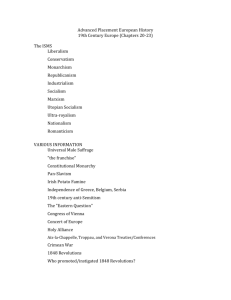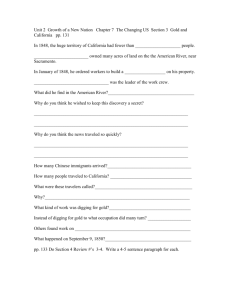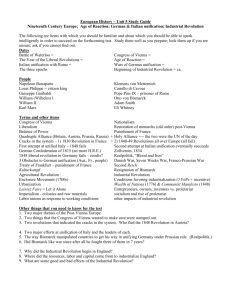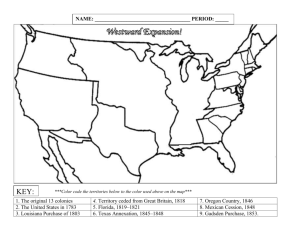Essay--Revolutions of 1848 "The revolutions did prove to those
advertisement
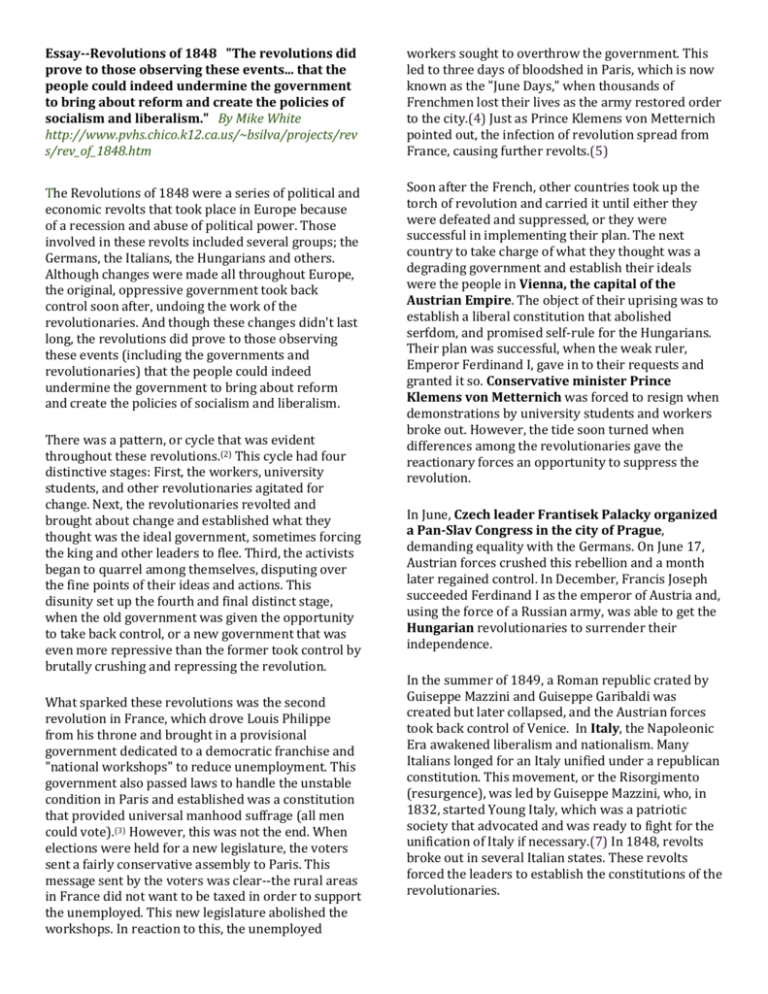
Essay--Revolutions of 1848 "The revolutions did prove to those observing these events... that the people could indeed undermine the government to bring about reform and create the policies of socialism and liberalism." By Mike White http://www.pvhs.chico.k12.ca.us/~bsilva/projects/rev s/rev_of_1848.htm workers sought to overthrow the government. This led to three days of bloodshed in Paris, which is now known as the "June Days," when thousands of Frenchmen lost their lives as the army restored order to the city.(4) Just as Prince Klemens von Metternich pointed out, the infection of revolution spread from France, causing further revolts.(5) The Revolutions of 1848 were a series of political and economic revolts that took place in Europe because of a recession and abuse of political power. Those involved in these revolts included several groups; the Germans, the Italians, the Hungarians and others. Although changes were made all throughout Europe, the original, oppressive government took back control soon after, undoing the work of the revolutionaries. And though these changes didn't last long, the revolutions did prove to those observing these events (including the governments and revolutionaries) that the people could indeed undermine the government to bring about reform and create the policies of socialism and liberalism. Soon after the French, other countries took up the torch of revolution and carried it until either they were defeated and suppressed, or they were successful in implementing their plan. The next country to take charge of what they thought was a degrading government and establish their ideals were the people in Vienna, the capital of the Austrian Empire. The object of their uprising was to establish a liberal constitution that abolished serfdom, and promised self-rule for the Hungarians. Their plan was successful, when the weak ruler, Emperor Ferdinand I, gave in to their requests and granted it so. Conservative minister Prince Klemens von Metternich was forced to resign when demonstrations by university students and workers broke out. However, the tide soon turned when differences among the revolutionaries gave the reactionary forces an opportunity to suppress the revolution. There was a pattern, or cycle that was evident throughout these revolutions.(2) This cycle had four distinctive stages: First, the workers, university students, and other revolutionaries agitated for change. Next, the revolutionaries revolted and brought about change and established what they thought was the ideal government, sometimes forcing the king and other leaders to flee. Third, the activists began to quarrel among themselves, disputing over the fine points of their ideas and actions. This disunity set up the fourth and final distinct stage, when the old government was given the opportunity to take back control, or a new government that was even more repressive than the former took control by brutally crushing and repressing the revolution. What sparked these revolutions was the second revolution in France, which drove Louis Philippe from his throne and brought in a provisional government dedicated to a democratic franchise and "national workshops" to reduce unemployment. This government also passed laws to handle the unstable condition in Paris and established was a constitution that provided universal manhood suffrage (all men could vote).(3) However, this was not the end. When elections were held for a new legislature, the voters sent a fairly conservative assembly to Paris. This message sent by the voters was clear--the rural areas in France did not want to be taxed in order to support the unemployed. This new legislature abolished the workshops. In reaction to this, the unemployed In June, Czech leader Frantisek Palacky organized a Pan-Slav Congress in the city of Prague, demanding equality with the Germans. On June 17, Austrian forces crushed this rebellion and a month later regained control. In December, Francis Joseph succeeded Ferdinand I as the emperor of Austria and, using the force of a Russian army, was able to get the Hungarian revolutionaries to surrender their independence. In the summer of 1849, a Roman republic crated by Guiseppe Mazzini and Guiseppe Garibaldi was created but later collapsed, and the Austrian forces took back control of Venice. In Italy, the Napoleonic Era awakened liberalism and nationalism. Many Italians longed for an Italy unified under a republican constitution. This movement, or the Risorgimento (resurgence), was led by Guiseppe Mazzini, who, in 1832, started Young Italy, which was a patriotic society that advocated and was ready to fight for the unification of Italy if necessary.(7) In 1848, revolts broke out in several Italian states. These revolts forced the leaders to establish the constitutions of the revolutionaries. In Sardinia, King Charles Albert was one who voluntarily granted a new constitution to his people. However, these strides in progress were soon crushed and repressed when in came the Austrian army. Charles tried to drive the Austrians out of north Italy, but was defeated at Custoza in 1848 and Novara in 1849 and was abdicated.(8) Revolutions elsewhere were suppressed, including one in Rome, where Mazzini had formed a short-lived republic. The movement for the unification of Italy was temporarily shut off until 1859. The wave of revolt also swept across the states of the German Confederation. In the spring of 1848, riots broke out as German people sought freedom from their repressive rulers. The Prussian king, Frederick William IV, was forced to agree to a democratic constitution and to support the unification of German states when the disturbance of the revolts became increasingly powerful. The Frankfurt Parliament was established to draw up a constitution for the unification. In May of 1848, members of the Frankfurt Parliament, or the National Assembly convened in Frankfurt to begin the writing of the new constitution. But the bright prospects of the new Assembly began to fade as members of the Assembly began to dispute over which territory to include in the new Germany.(9) This dispute forced them to a compromise, and a constitution that would accept Frederick William IV to be the head of this new government. However, Frederick refused to take this position, delivering the famous line, "I do not accept a crown from the gutter!", and had, by this time, gained control of the Prussian army once again and soon brought the demise of the Frankfurt Parliament. Once again, as in Italy and others, hopes for unification were crushed momentarily, this time until 1866. These revolutions all did one thing together; that the people did have the power to overtake the government and establish what they thought as the ideal government that was run by their constitution. And even though the Italian and German revolts did not last, they too showed their strength in their national feeling. Eventually, the revolts led to reform and ultimate success under different leaders and different years. But in 1848, the main result was gained respect and intimidation from the revolutionaries and their leaders. Spain – 1820-23 Goal: to confirm liberal concessions Result: revolution suppressed Two Sicilies – 1820-21 Goal: to protest a repressive monarchy Result: revolution suppressed Russia – 1825 Goal: to protest the succession of reactionary autocrat Result: revolution suppressed Greece – 1821-32 Goal: to obtain independence for the Ottoman Empire Result: independence achieved France (I) – 1830 Goal: to overthrow a reactionary monarchy Result: establishment of a liberal monarchy Belgium – 1830 Goal: to assert independence Result: independence recognized Poland – 1830 Goal: to demand national autonomy Result: movement crushed and further Russification imposed France (II) – 1848 Goal: to overthrow a liberal monarchy that had become reactionary Result: establishment of a republic-under Napoleon Hungary – 1848 Goal: to assert national independence Result: movement crushed Prussia – 1848 Goal: to demand constitutionalism Result: rebellion subverted Austria – 1848 Goal: to oppose stringent conservative government Result: new conservative government German States – 1848 Goal: to oppose backwards monarchies and strive toward unification Result: failure Bohemia – 1848 Goal: to obtain Czech/Slavic autonomy Result: movement crushed

